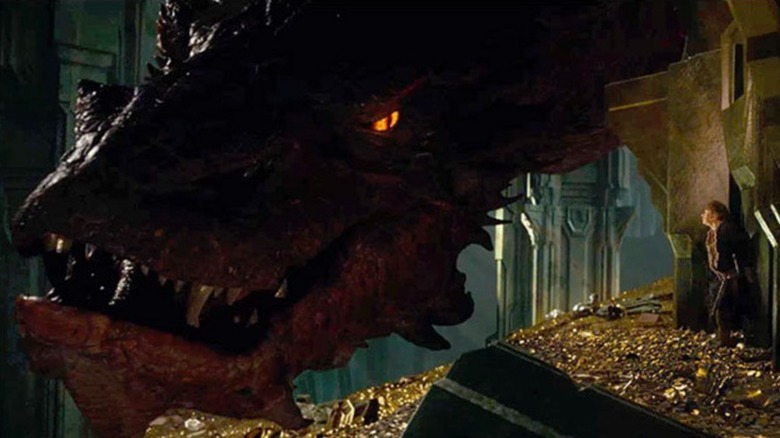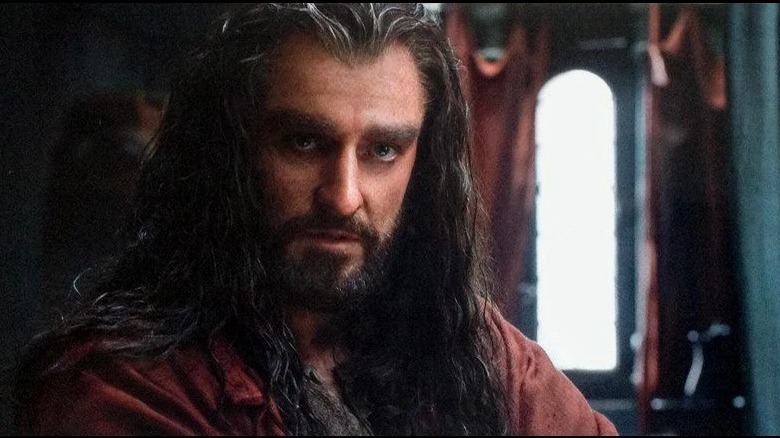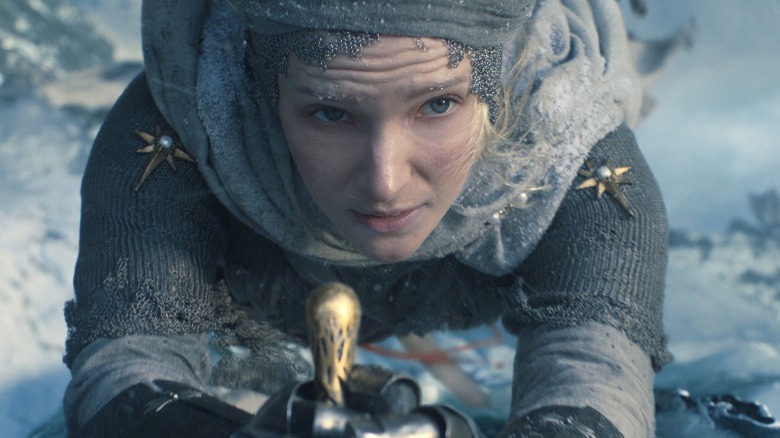Is Smaug Alive During The Rings Of Power? Where Middle-Earth's Dragons Came From
Dragons are really hot right now. The fire-breathers are about to take center stage on HBO, where the "Game of Thrones" prequel series "The House of The Dragon" will feature no less than 17 of them. They're also the star of Christopher Paolini's popular "Inheritance Cycle" books, which are finally set for a Disney+ adaptation. But there's one fantasy world set to captivate viewers that has shown neither hide nor tail of the great beasts: trailers for Prime Video's massive new "Lord of the Rings" prequel series, "The Rings of Power," are conspicuously dragon-free.
There's a good reason that footage of this latest version of Middle-earth is populated by elves, dwarves, humans, and Harfoots but lacks an appearance by the biggest, fiercest creatures around. In short, the series takes place during the Second Age of Middle-earth, and J.R.R. Tolkien never wrote any dragon stories set during that time. In "The Silmarillion," Tolkien tells of the creation of the first dragons, which came into existence during the era of the dark lord Morgoth (also known as Melkor) early in the First Age. In "The Hobbit," our furry-footed heroes defeat Smaug, the last named dragon in Tolkein canon, during the Third Age. But in-between, there are thousands of years with few dragon tales to speak of, and the events of "The Rings of Power" fall sometime during that era.
The creation and lifespan of dragons
Now, just because Tolkein never shared insight about what the dragons were up to during the off-season, that doesn't mean they weren't around. As "The Silmarillion" explains, the lifespan of a dragon is "long and slow," and if Thorin Oakenshield is to be believed, they could live on pretty much indefinitely if not slain. In "The Hobbit," Thorin describes dragons' longevity by saying, "They guard their plunder as long as they live (which is practically forever, unless they are killed)."
Intriguingly, although Tolkein has written that Morgoth was in some way responsible for the rise of dragons, the author never digs into their creation with much clarity, leaving readers to speculate about whether they're the embodiment of immortal Middle-earth spirits called Maiar. Morgoth is also credited with creating Orcs, yet repeatedly, Tolkein texts mention that evil forces cannot create new beings. So if the orcs and dragons came from Morgoth, does this mean he transformed other lifeforms to create them? This is a question "Lord of the Rings" fans have debated for decades, and likely not one the new series will answer, since it appears to be set long after Middle-earth's creation era.
Could we meet baby Smaug?
There's also a little bit of semi-canonical evidence that dragons continued to make their presence known in the Second Age of Middle-earth. After Tolkein's death, his youngest son, Christopher Tolkein, put together a book called "The Peoples of Middle-earth" which included additional information about the prologues and appendices of his father's works and pulled from unpublished writings.
In one essay, "Of Dwarves and Men," Tolkein describes the War of the Elves and Sauron, an event that took place in the Second Age, making reference to orcs who were "reinforced and commanded by servants of Sauron." As Tolkein blogger Michael Martinez points out on his website Middle-Earth Blog, it's possible that these servants of Sauron could include dragons. Tolkein mentions servants of Sauron without specifying what they are a few times throughout his works and appendices, but this theory is admittedly thin: you'd think the author would take any chance he could get to mention dragons. Still, if the last dragon we know by name died off in the Third Age, this should mean some were around in the Second Age, even if they didn't raise enough chaos to make the history books.
So does that mean the dragon Smaug could make an appearance in "The Rings of Power"? The behemoth's earliest appearance in Middle-earth lore come thousands of years into the Third Age, when he attacked the town of Dale, a story that's shared in Peter Jackson's "The Hobbit: An Unexpected Journey." He was also already tremendously large at that time, and presumably full-grown. Since we've never heard about specific new dragons being born in the Second or Third Age, it's possible that Smaug or another dragon is hiding in a mountain somewhere during the events of "The Lord of the Rings: The Rings of Power." Hopefully, our new heroes will tread lightly when they go adventuring.


